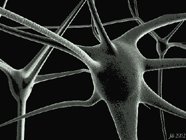Task Switching in Prefrontal Cortex
 During complex tasks, we may have to switch our attention between multiple task demands, and maintain information about what we're currently doing as well as the end goal. Unfortunately, those tasks which require rapid or frequent shifts of attention are often the most difficult, or in other words, the most subject to "switch costs."
During complex tasks, we may have to switch our attention between multiple task demands, and maintain information about what we're currently doing as well as the end goal. Unfortunately, those tasks which require rapid or frequent shifts of attention are often the most difficult, or in other words, the most subject to "switch costs."Performance in these task switching paradigms is thought to be driven by specific regions of prefrontal cortex, which may subserve the active maintenance of goal- or task-related information. According to Reynolds, Braver, Brown and Stigchel's article in press at Neurocomputing, analyses of switch cost distributions suggest two distinct modes of behavior; one stochastic distribution of fast trials with low or no switch costs, thought to be a result of successful suppression of task-irrelevant representations, and a second stochastic distribution of much slower trials which reflect the unsuccessful suppression of the pre-switch learning, task set, and resultant priming. Whether a trial contains low or severe switch costs is thought to be a function of a dopamine-based gating signal sent from basal ganglia to prefrontal cortex.
To test these hypotheses, the authors developed a computational model using the biologically-plausible LEABRA algorithms of the pdp++ modeling environment. Many implementational details are provided in the paper, but for our purposes the most important aspect is the modeling of a phasic dopamine signal: this gating input serves to activate a hysteresis current in prefrontal cortex, which allows PFC activity to become self-sustaining (and hence maintain the current goal or task). In the absence of this gating signal, PFC activity dies out and therefore more stimulus-specific and posterior regions are not as heavily biased towards the current task. In this latter case, the effects of priming and previous learning are more pronounced, and therefore switch costs are higher.
As often happens with neural network models, this model emergently manifested several other phenomena seen in human studies of task-switching. For example, task switch trials were less accurate, slower, and different from non-switch trials by roughly the same magnitude as in the empirical literature.
Related Posts:
Models of Dopamine in Prefrontal Cortex
Anticipation and Synchronization


0 Comments:
Post a Comment
<< Home